
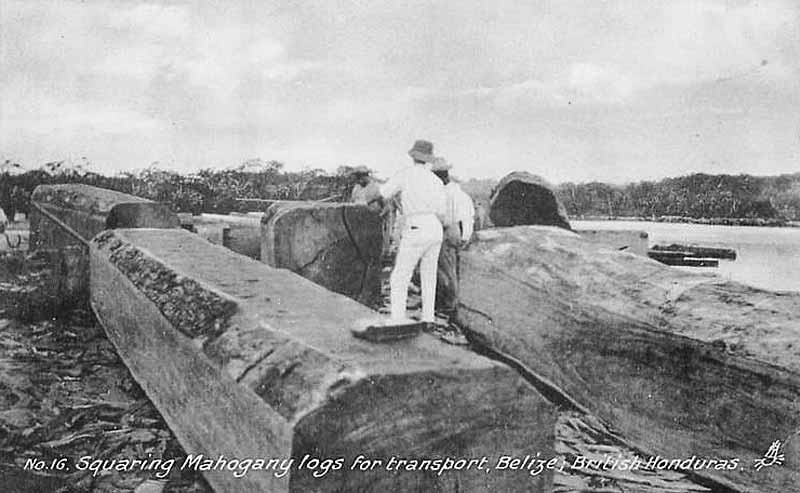
Squaring mahogany logs for export. This impressive size is probably in line with mature old growth Mahogany. Source: Handbook of British Honduras by Monrad Metzgen and Henry Cain.
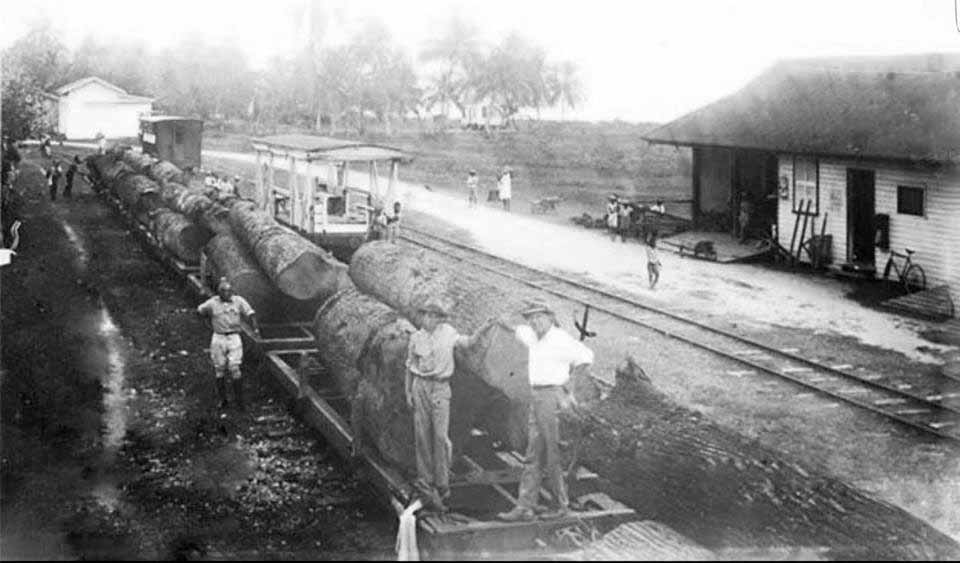
Mahogany workers at Hillbank in the 1930s, look at the size of those logs. The logs were in some cases over 6ft in diameter.
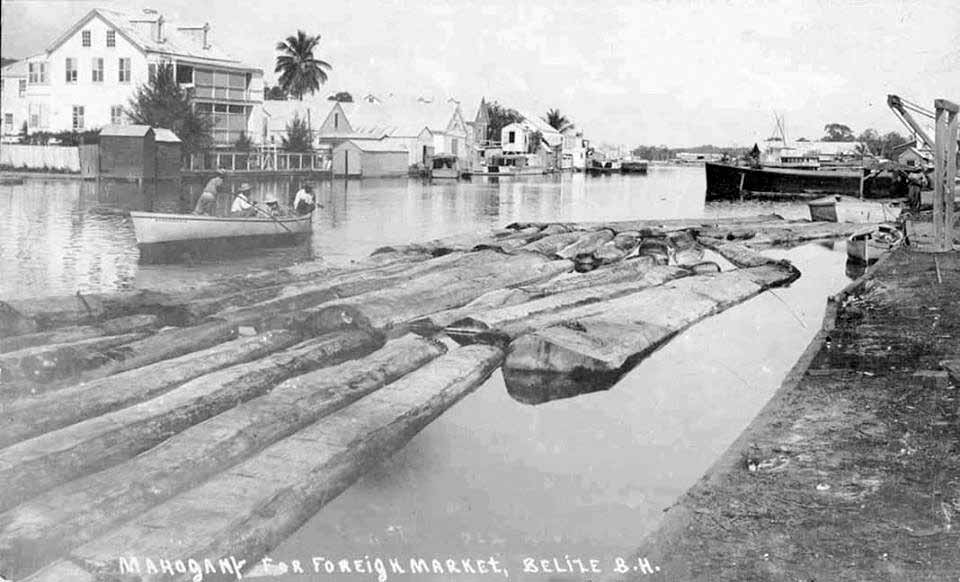
Mahogany Logs, Belize River, 1930s. These were among the giant mahogany trees, which were extracted from our Belizean jungles.
I had the privilege of seeing these thousands of trees going down the Belize Old River, when in flood.
How did we know the size of these giants? By watching how many logs went by, but when these passed they would halt and begin to bounce. These would remain still, until a bigger flood passed by to float them away.
As they went by, names were given to those logs like, Tarzan, King Kong, Goliath, Joe Louis, Jack Dempsey etc.
The question is "Are there still, logs like these? My answer is of course YES."
There is the Chiquibul Reserve, The Cock's Comb Reserve, The Columbia Reserve.
I heard many years ago, that mahogany trees were abundant in the Cocks Comb Reserve but that it would have to be extracted by air, ( A chunnok helicopter.) Hector Silva
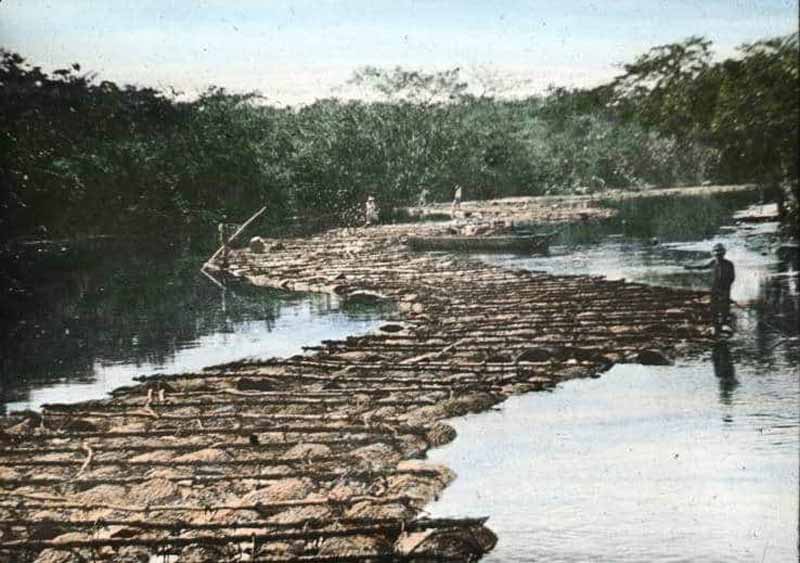
Log Boom 1900s. I lived along the Haulover Creek for 35 years and I saw many things in the river and one of the things I got to see was these logs being pulled through the creek. The logs trailed behind the tug boats what seemed like hundreds of feet. Don't know how they made that turn from the Belize River into the Haulover Creek. Regent Albert
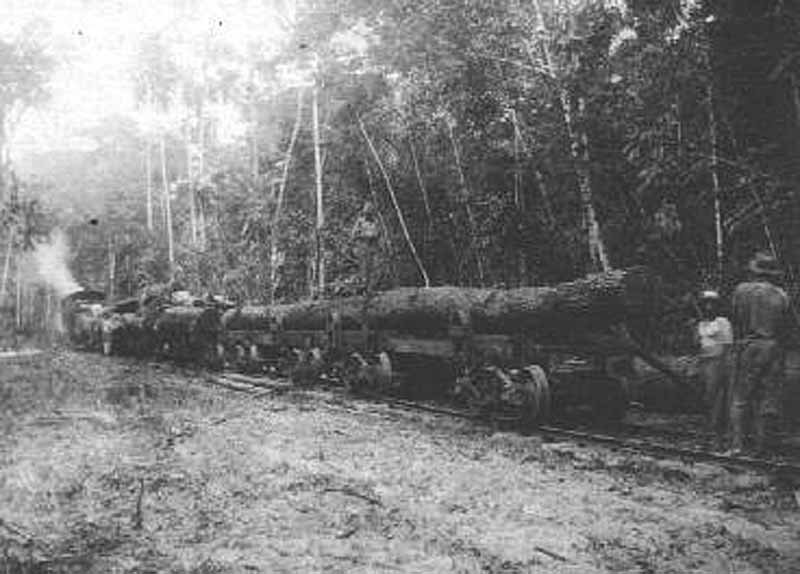
Neil Fraser collection, Hill Bank 1912-14
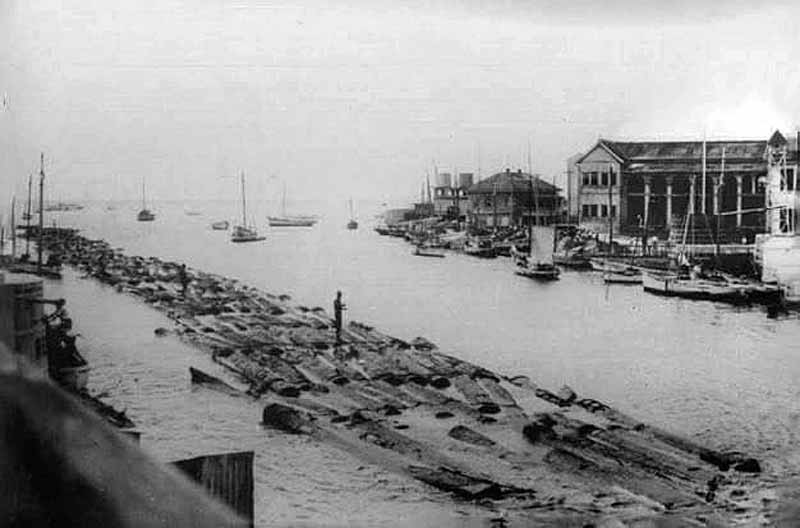
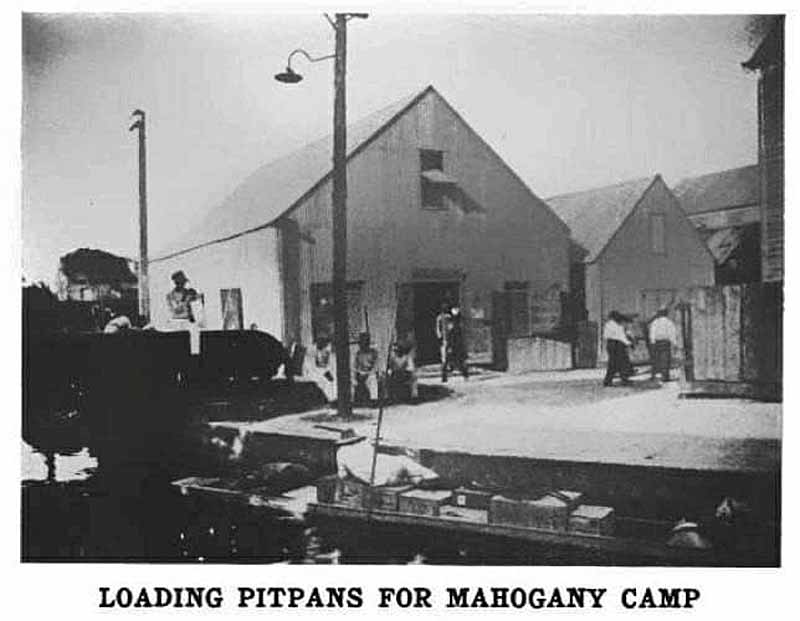
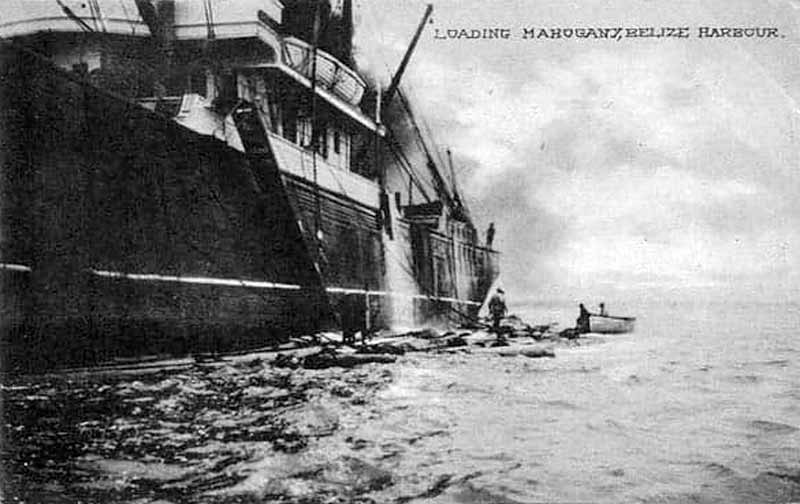
Loading of mahogany, Belize Harbour.
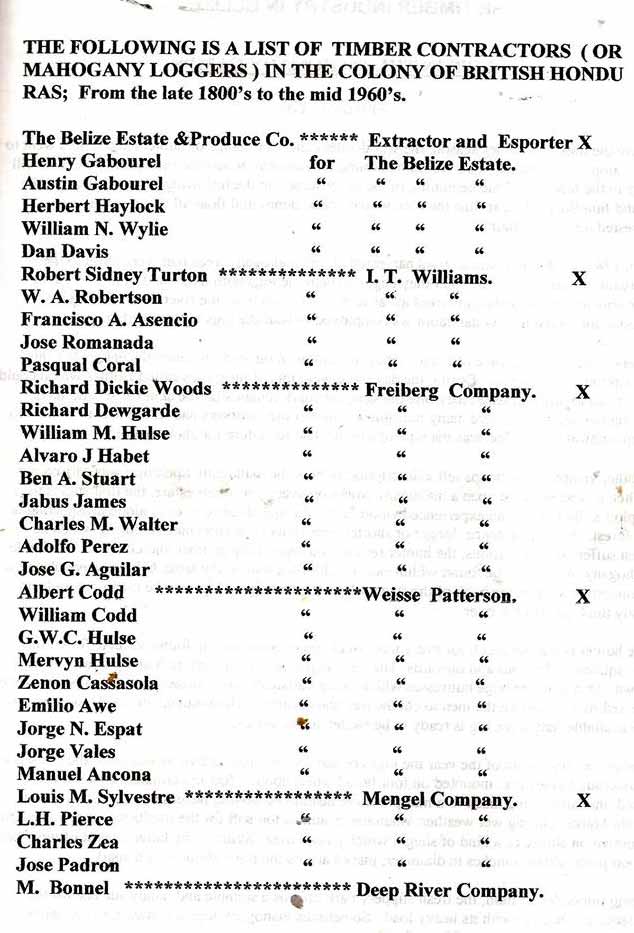
List of mahogany contractors from the late 1800's to the mid 1960's
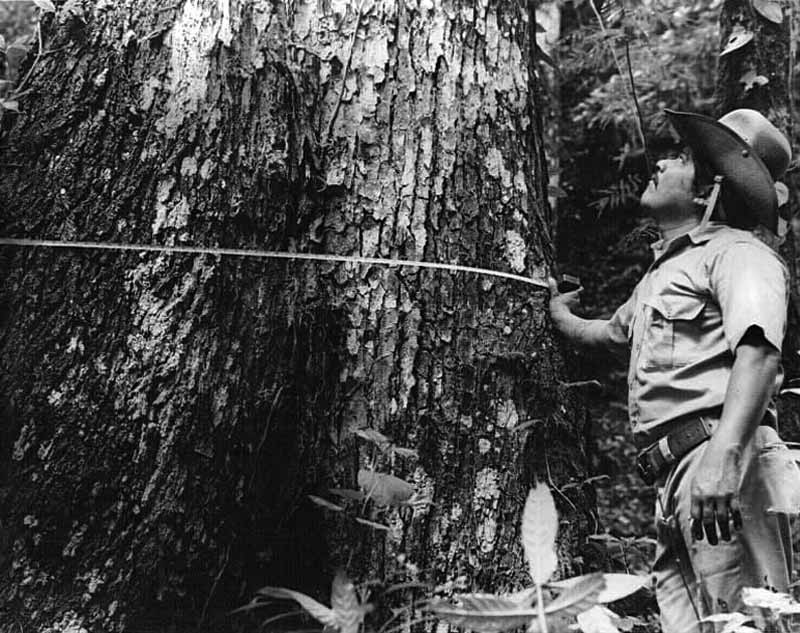
Timber cruiser figuring out board feet in a section of bush, 1985. Calculating board feet of lumber by measuring girth and estimating height of usable log. Then they can use data to estimate royalty payable to the Forestry or Government department.
 Loggers squaring mahogany in Belize, around 1930, also video on Long Lost Logs from Belize, and a list of mahogany contractors from the late 1800's to the mid 1960's
Loggers squaring mahogany in Belize, around 1930, also video on Long Lost Logs from Belize, and a list of mahogany contractors from the late 1800's to the mid 1960's
The Logwood era continued long after slavery.
Those huge logs was cut manually by two black men, with a 10 ft. handsaw.
They were placed in different area of the forest, falling Mahogany, Redwood, etc, as they rolled into the river.
It was the African slaves of British Honduras who cleared this swamped land now called Belize. Simply by building an elevated platformed called babecue to a convenient height, and then the professional axe men did what they knew to do with their felling axe.
Axes were in differing types. felling axe, cutting axe, squaring axe.
In 1667, a treaty was passed that outlawed buccaneering, many out-of-work pirates, turned to the mahogany trade in Belize. During this period, mahogany was used as dyewood in England and was indispensable in the process of dyeing cloth black, gray, purple or dark red. Initially, the pirates did not know its value and when captured ships filled with "logwood", as the pirates called the mahogany, they used if for firewood! One day, a certain Captain James sold off his surplus of logwood and was shocked to realize its value. (This paragraph an excerpt from an article by Dalton Gonzalez)
"How many slaves did it take to remove Mahogany trees from the rainforest of Belize?"
According to Nigel Bolland the process of extracting Mahogany was so intense it took 10 to 50 slaves working in small groups to complete the task.
Mahogany was the main Export of Belize for over 150 Years. Today all the BIG trees are gone.
No one ever bothered to plant any back for reforestation, so production has slowly dwindled. Now it’s the Rosewood that is being illegally cut and deforested.
The large trees were common in Belize before 1930s, and now they are extremely rare. We note of a of Cotton Tree behind Rancho Dolores that is over 20 feet in Diameter that exists today.
Mr John Frampton, when he ran the saw mill for BEC near the Belize Airport said even in the 60's and 70's some logs that came from Hillbank were so huge that they were unable to fit on the carriage that was suppose to take them from the river side up the slope to the actual mill where the massive saw was located. Therefore he had dealt with those massive logs or trunks differently.
It is interesting to note that many mahogany kneading and washing bowls were made from the purrs of these huge trees up until the late 70's.
Today mahogany wood is found in almost every home in Belize and is a choice wood for local artisans in Corozal.
There currently exists in our remote areas and forests of Belize, many very large trees yet to be publicized. There are also many other such trees throughout the country of Belize.
Leonardo Castro:
Here in Monkey River. One elder told me when the logging industry was was in full effect, seven people or more used die every week. This was a brutal industry. In those days the ships used anchor in front of Monkey River town to collect the logs.
Click here to comment on this picture.
Belize Slideshow
Treasure Found - Long Lost Logs from Belize
This video gives you an overview of the early logging methods once used to harvest Mahogany in Belize, (once known as British Honduras), and what is being done about all the logs that were lost to the bottoms of rivers and lagoons during 200+ years of Mahogany harvest.
Timber Industry in British Honduras, 1930's
Scenery , mountains and rivers , tropical rainforests and mahogany trees. Workers in a camp, hand cut trees, trees trimmed off , cut into logs , tractor drags the wood though the rainforest and floated down the river to the sawmill at Belize . Sun dried and exported rare woods.




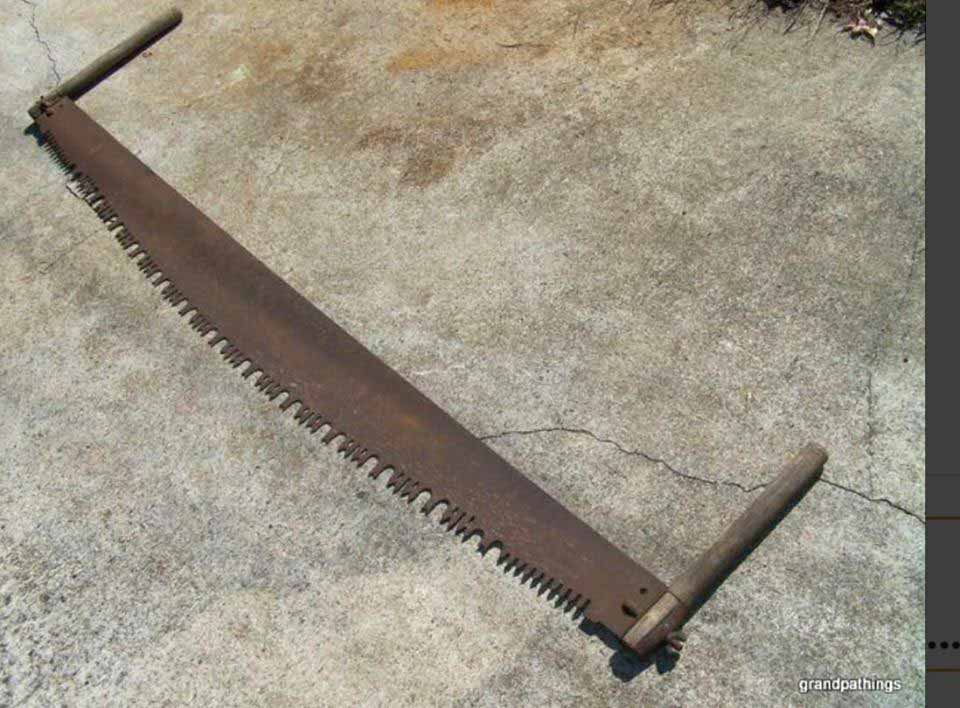
While the first bust cycle in logwood was occurring in the 1770s, Belize’s early settlers were able to start the transition to a new resource for extraction and mercantile trade with Britain: mahogany (Swietenia macrophylla). Belize mahogany was very valuable because it was easy to work by sawing, drilling and mortising and because it would not change shape when it became damp or split if it became very dry. Belize mahogany was known to be perfect for making doors and window frames, furniture and railroad carriages in the peculiar British climate. Furniture manufacturers in England like Thomas Chippendale and George Hepplewhite created high priced furniture from Belize’s mahogany.
Extraction of mahogany in Belize was a more difficult process compared to logwood harvesting because mahogany were much larger trees which had to be extracted as 10-20 feet logs. The major processes required for this trade included (1) locating mahogany trees, (2) felling the trees, removing the limbs and cutting the trees into manageable logs (3) moving the logs to the banks of major rivers, (4) slipping the logs into the rivers in the rainy season, (5) storing the logs at booms, (6) sorting the logs per owners at the booms, (7) floating the logs to the river mouths, (8) squaring the logs and (9) loading the squared logs or lumber on to ships bound for Europe.
These steps required a technological shift away from the era of logwood exploitation. Differences between the industries included the fact that mahogany trees were much more difficult to locate because these were randomly distributed throughout the land. Secondly, mahogany trees were much larger and they required more advanced technology for felling. This prompted the development of “barbeques” which the axemen would build above the buttress roots of the trees to avoid chopping into the buttress roots. The barbeques were often made 10 to 12 feet off the ground. It is said that two men could fall a tree per day on contract work. While axemen were felling the trees, other workers in the gang would clear a path for the transfer of the tree to the nearest water course. This was different from logwood which was carried as small blocks which an individual could manage. Haulage of large 10 or 20 foot mahogany logs was a process requiring much more manpower. As a result, the British began importing more and more African slaves into Belize
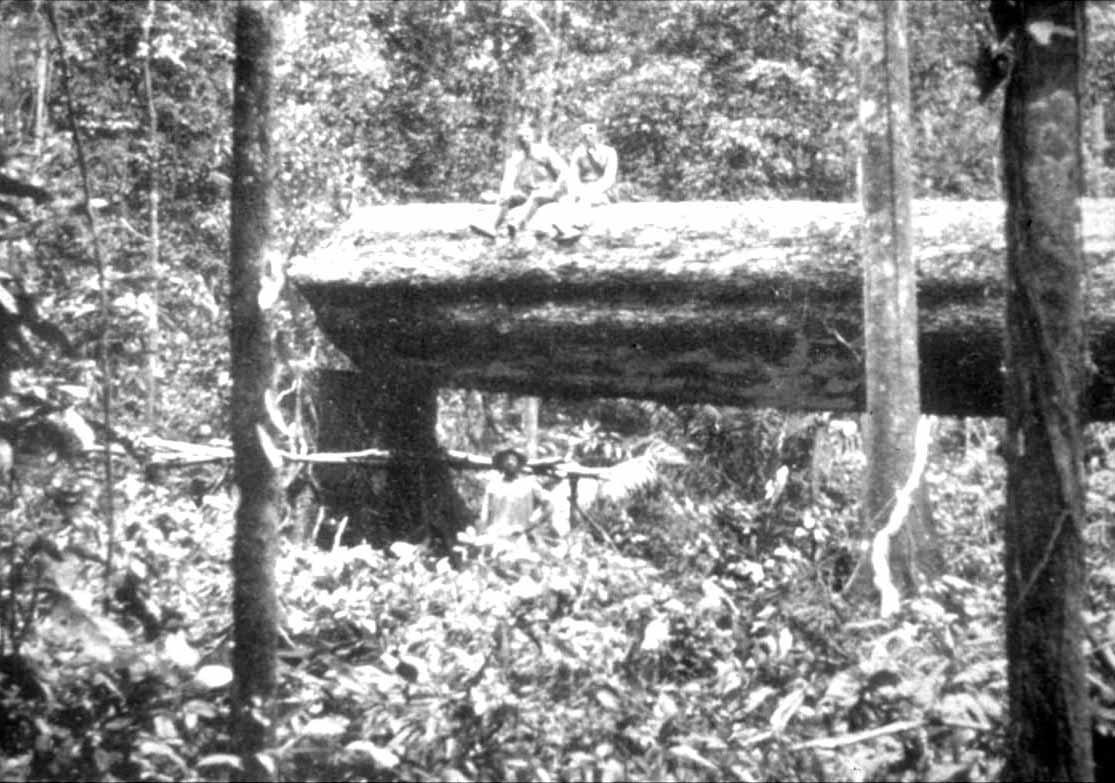
A platform for mahogany cutters, circa 1926, you can just barely make out the cutters on and below this giant of a tree.
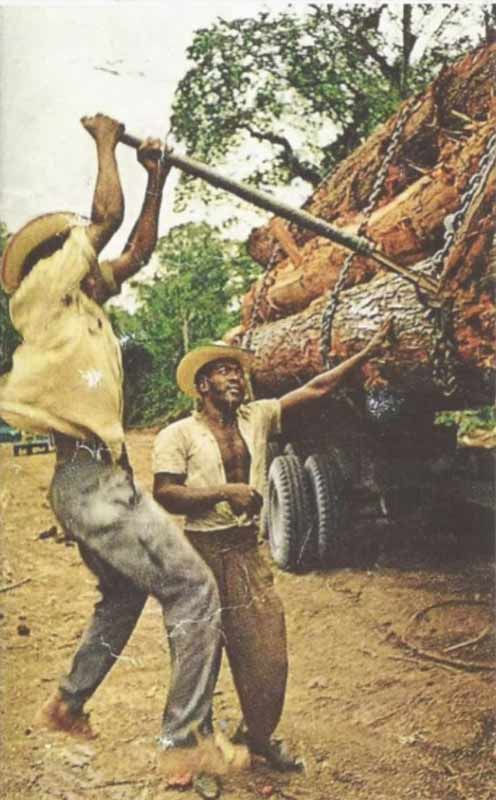
The Belizean Economy was Established and Built by the Hewers Of Wood. Yes, logging was the very first industry in Belize. The toiling was hard and dangerous. The loggers did not have the type of modern tools to work with that are available today. And even today what is being worked with is obsolete compared to what is being utilized in Canada.
Our woodcutters were hardworking and skillful. Frederick Vernon. Photo by National Geographic magazine.

One of many mahogany trees in British Honduras, circa 1926. From my military work in the great Chiquibul rainforest 1968 to 1984 we saw an abundance of all prime logwood, mahogany and cedar included. There were some that were bigger than the one in this photo. There was a mahogany tree on the west side of the plateau atop the Maya mountains that grew on a steep slope. No cutting that one, as it would tumble 1000 feet to a deep gorge. It took 6 of us hold outstretched hands to encircle it. Pity I had no ability to photograph that at the time. Tom Greenwood Sr.
Below four images, Lumber production of British Honduras/ Belize 1924-1985
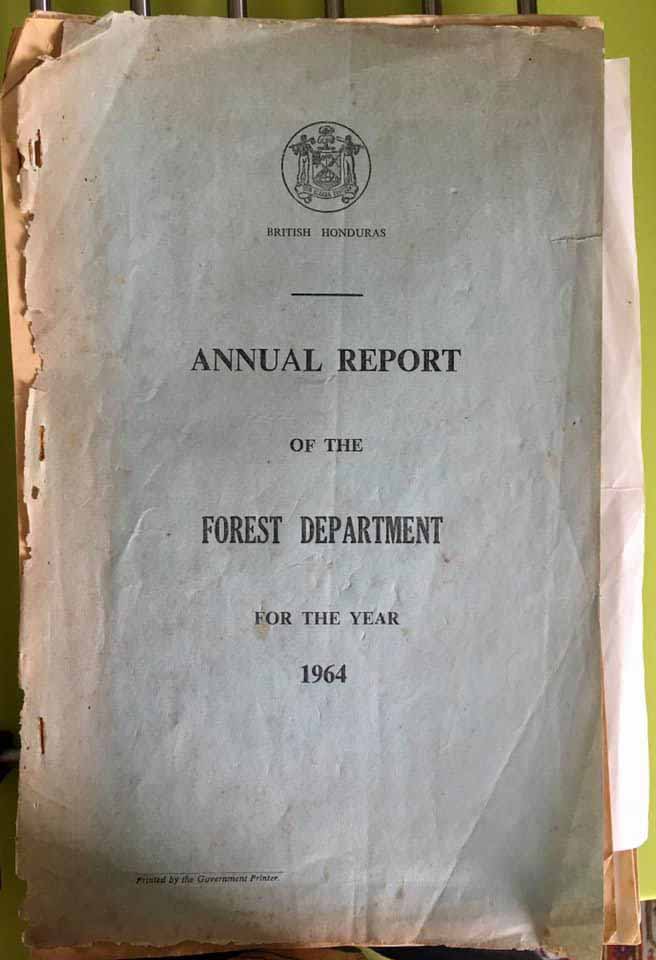
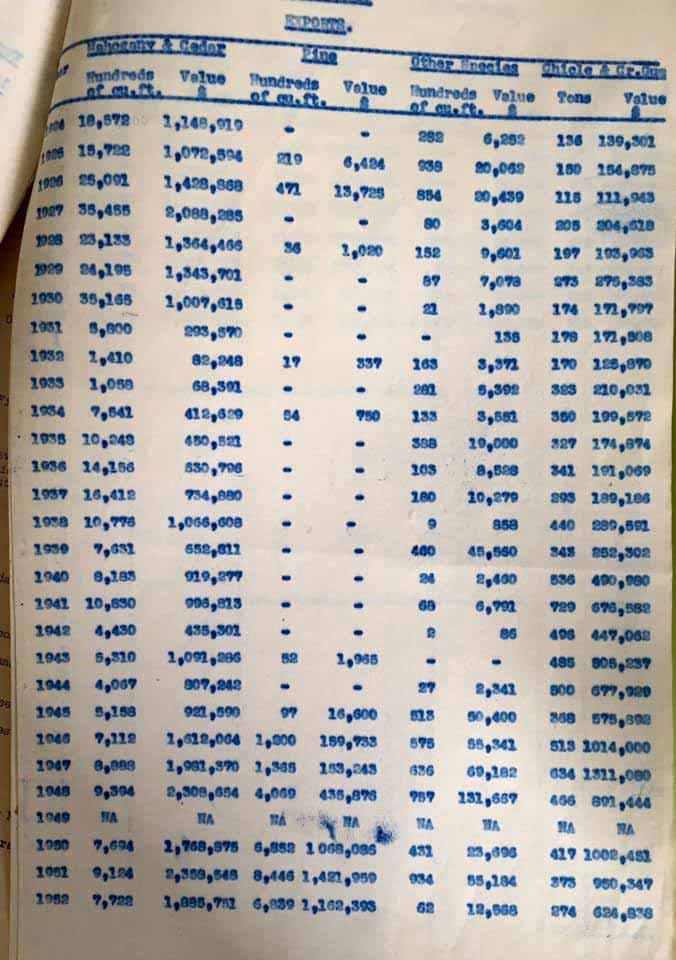
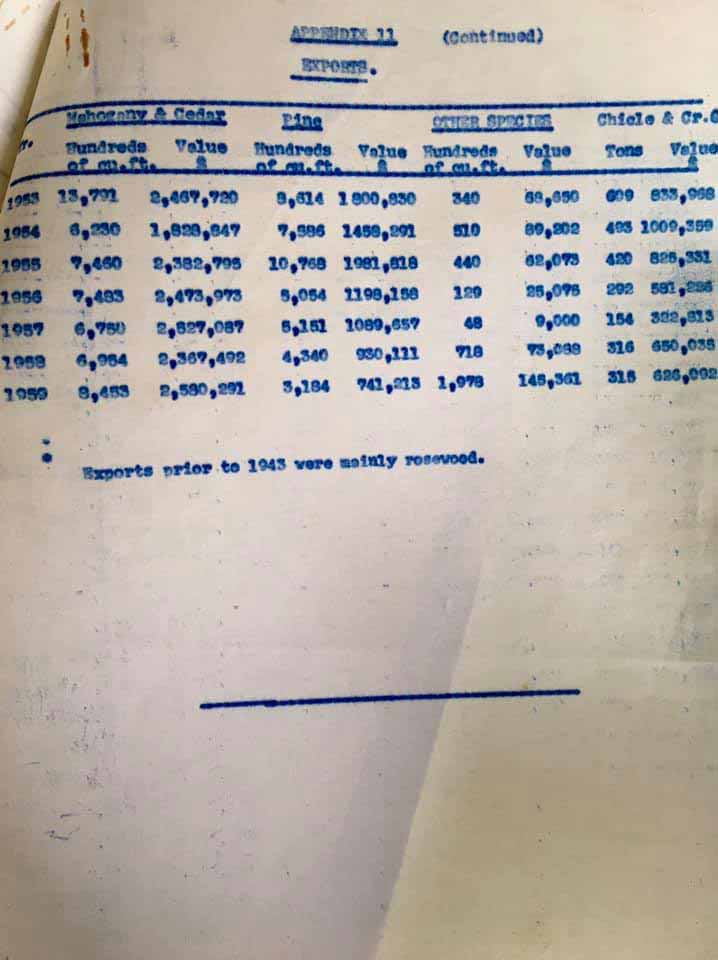
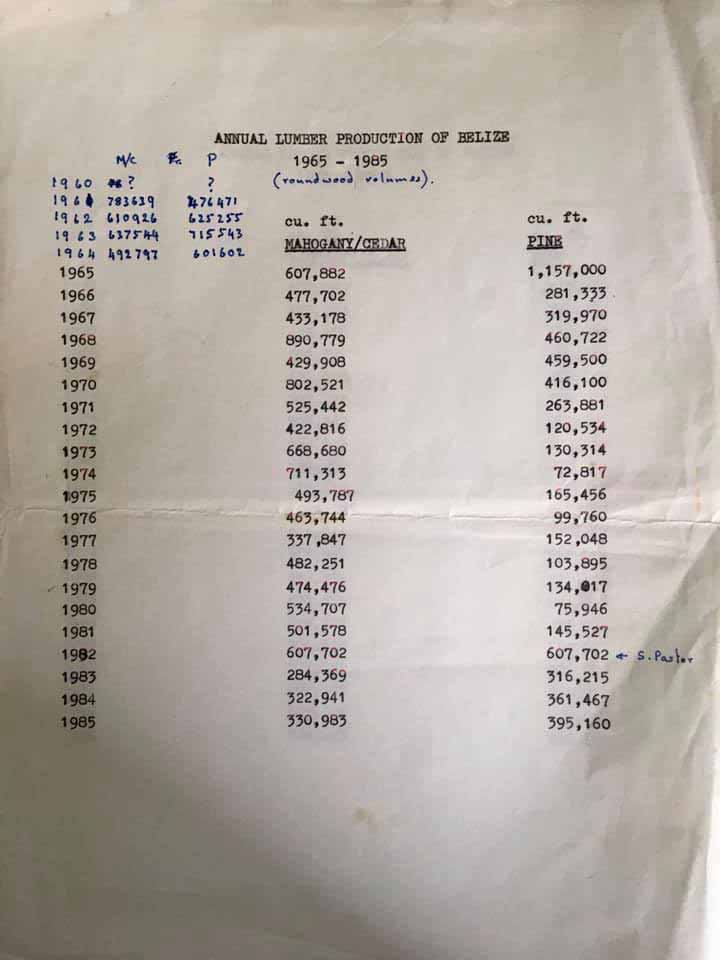

Stephen Fairweather in his book Baymen of Belize has old records for the late 1700s n 1800s showing exports to the USA; this is when the British preferential tarrif made it difficult for loggers to sell up North. Dr Grant shares only the tip of the iceberg from 1910 to 1932. It adds up to 48,708,786 sq ft. Google guesstimates 60 board feet for an average tree. I am waiting for a mathematician to guesstimate how many trees were cut between 1910- 32. Using the 60 board feet approx 800,000 trees were exported during that period Someone once told me if we were able to put the cut trees head to foot, they would measure the distance to England n back to BH twice.

These are mahogany logs ready for export. Only a few weeks/months before this photo was taken these mahogany trees were happily blowing in the tropical wind enjoying the company of other mahogany trees. From the diameters of these trees, they seem quite young. Merely teenagers in the long life of a mahogany tree. Then all hell broke loose for them. They were cut, dragged, floated down a river, cut again, dragged again, floated again and finally hoisted on a boat where they laid in this photo waiting to be reborn. If you were a mahogany tree in the 1700's to early 1900's this would have been your faith. The irony here is that these mahogany trees are stocked in similar fashion to how the people who were forced to cut them were stocked in their trans Atlantic voyage to this side of th4e world only a few decades earlier. This Photo is showing Stevedores standing on top of Mahagony Logs which was loaded on a ship's deck (deck cargo). The Stevedores being there, and the logs have not been binded down as yet means that the loading process had not yet been completed. Note the Stentions on the sides of the ship to stop the logs from rolling off.
The fact that logs are being loaded on the deck means that the ship's cargo holes has already been loaded. What you are actually seeing is only the tip of the Iceberg, so to speak. Since the majority of the cargo would have to be loaded below in the cargo holds. If not the ship would get top heavy and roll over whiles sailing in rough seas.
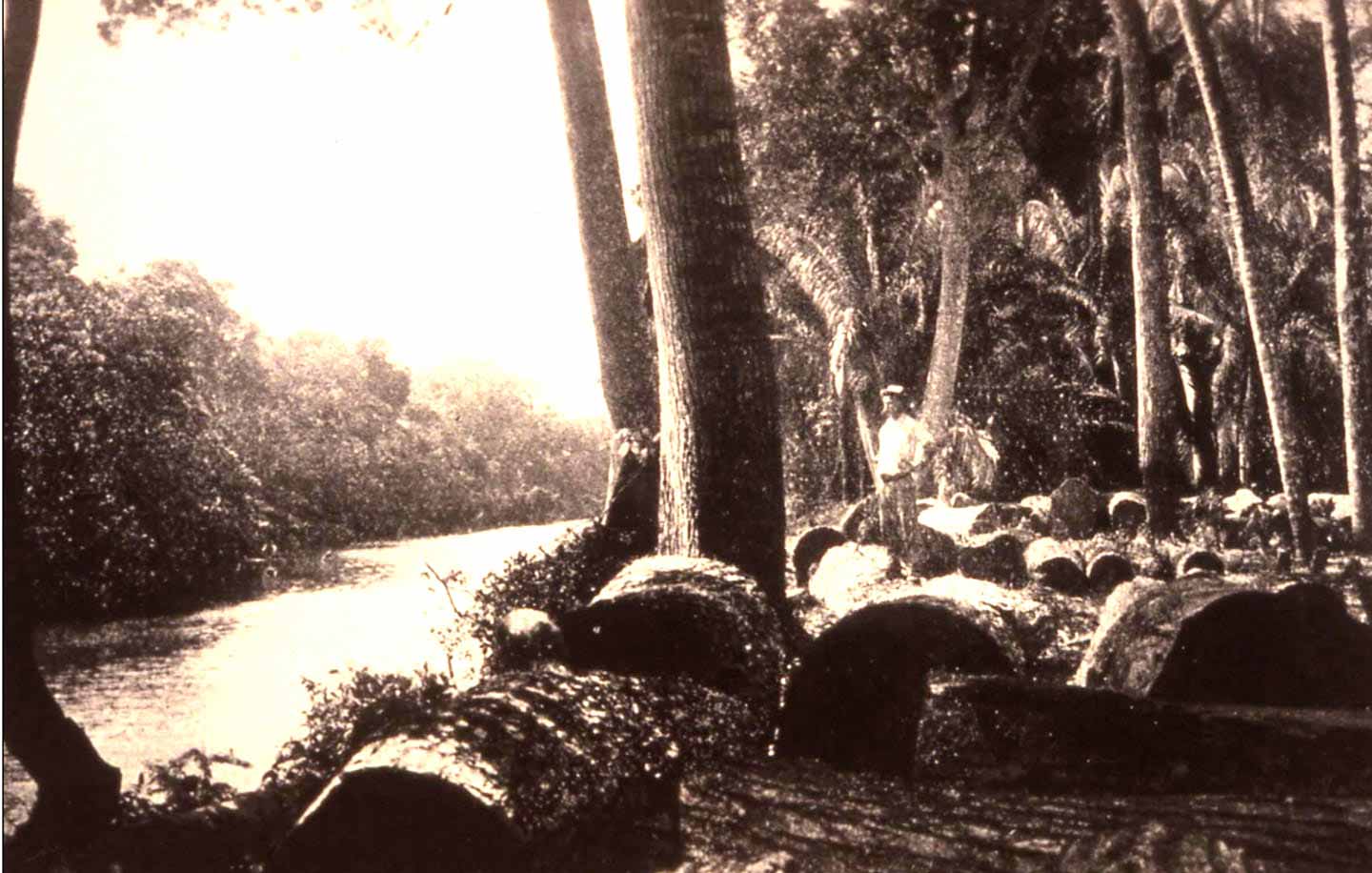
Staging mahogany on a river bank, circa 1925.
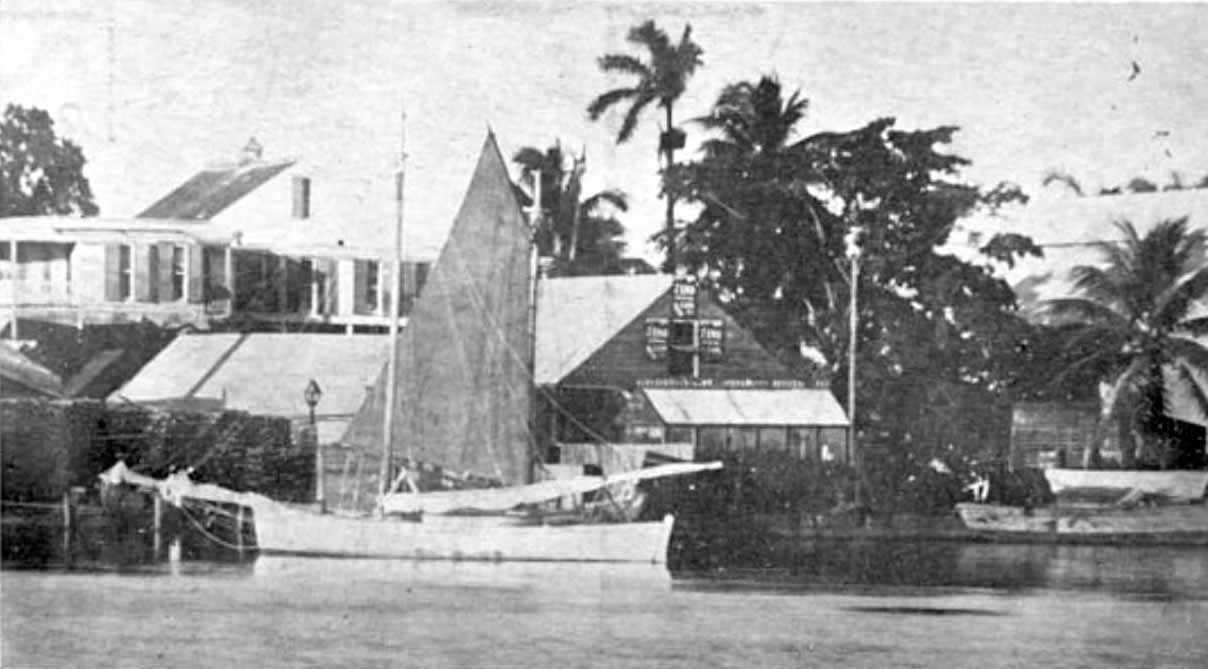
Logwood wharf circa 1906.
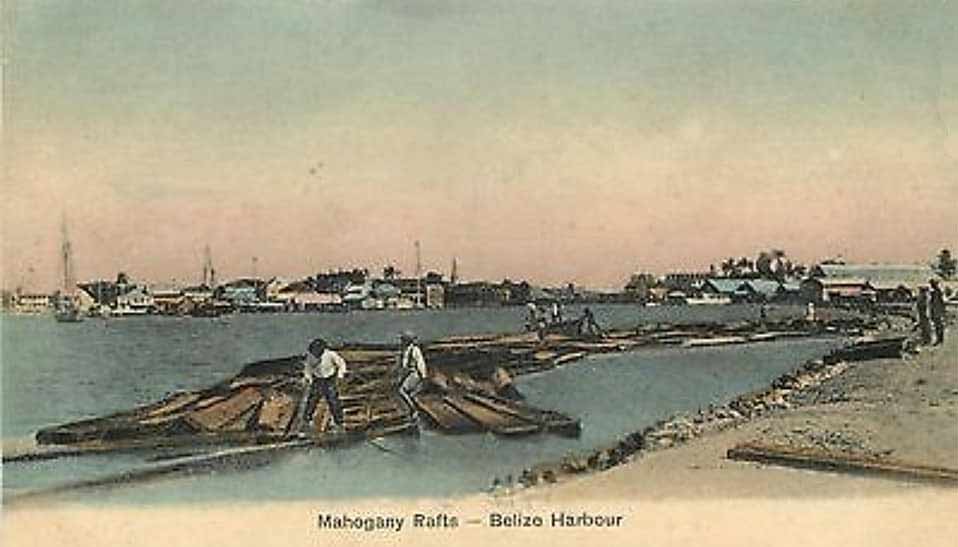
Jeremy A. Enriquez: Belizean history hardly mentions the fact that Garifuna woodcutters played a pivotal role in the early economy of Belize and the expansion of the territory from its then border at the Sibun River to the Sarstoon. How did this happen? Around the 1790s there continued to be a high demand for mahogany in Europe. But there were two major problems: (i) virtually all the stands of mahogany within the established border up to the Sibun River had been harvested, and (ii) there was a shortage of labor since the enslaved ran away to neighboring territories with such numbers that the very existence of the settlement was threatened. Given the heavy losses of enslaved Africans the masters had no choice but to seek labor elsewhere.
That’s when they decided at a public meeting in 1802 to import Garifuna men from Roatan where they had been living since their exile from St. Vincent in 1797. Recall that in all the Americas where slavery was the dominant feature of the economy, Garinagu were the first, and one of the only, free group of Black people. Between August and December 1802, 150 Garifuna were imported and hired to cut mahogany south of the Sibun. By law they were not allowed to live in the Belize settlement for fear that they would fuel rebellion among the enslaved. During those years, the masters used all sorts of divide and conquer tactics to divide the Creoles and Garifuna so as prevent any threats that a united group of blacks might pose on the minority white settlers. That is why all Garifuna communities historically remained south of the Sibun River. That was also why Garifuna were forbidden by a law in 1811 to visit the settlement for more no more than 48 hours with a permit.
From Sibun to the Sarstoon Garifuna men fearlessly roamed the forest in search of and for harvest of mahogany, thus providing the labor needed to enrich the white forestocracy. Importantly, their labor was also critical for the expansion of the territory. Subsequent migration of Garifuna families led to the formation of Dangriga, Punta Gorda and other communities. Between the 1840s and 1860s, the firm Young, Toledo & Company was granted one million acres of land in southern Belize with concessions to log mahogany. One of the main owners of this company was a Central American investor named Felipe Toledo, from which the district got its name.
Because of their history of resilience and toughness in dealing with the challenges of working in the deep forests, as well as their history of speaking multiple languages (Spanish, English, Garifuna), the descendants of these woodcutters were hired and trained by the Catholic church to open and head schools in remote communities all over Belize for near a century starting as early as the 1880s. Interestingly, after all those stellar historical Garifuna contributions to the foundation of the Belize, Garinagu communities in the resource rich southern districts remains impoverished and marginalized, while many were forced to migrate abroad or out-district, to sustain their families.
This earlier group of 150 Garifuna woodcutters that were brought in from Roatan were actually the first group. Others followed in subsequent years. What is celebrated on November 19th each year is the mass influx of a much larger group, two decades later, that was fleeing persecution following the war of independence in neighboring Republics. Because the Garinagu were accused of taking sides with the Spanish colonialists during those wars, when the colonialist lost, Garinagu feared for their lives, believing that the nationalists would seek horrendous revenge. That fueled their mass migration into Belize, to join others who were already here. That flight from danger, that mass migration, is the event that is celebrated in Nov. 19th, rather than the actual arrival of the first 150 laborers.
Garifuna woodcutters later worked in forests all over the country wherever there was timber to be harvested. Another history that is also hardly discussed is the impact of their regular absence from their families as they spent weeks in the jungles.
Today, as in colonial times, while Garifuna representation in government leadership remains bleak we still remember the contributions of the woodcutters who played in important role in stabilizing and expanding the territory, as well as the teachers whose tremendous sacrifices helped to lay the foundation for formal Catholic education in remote Maya, Mestizo and Creole communities all over Belize.
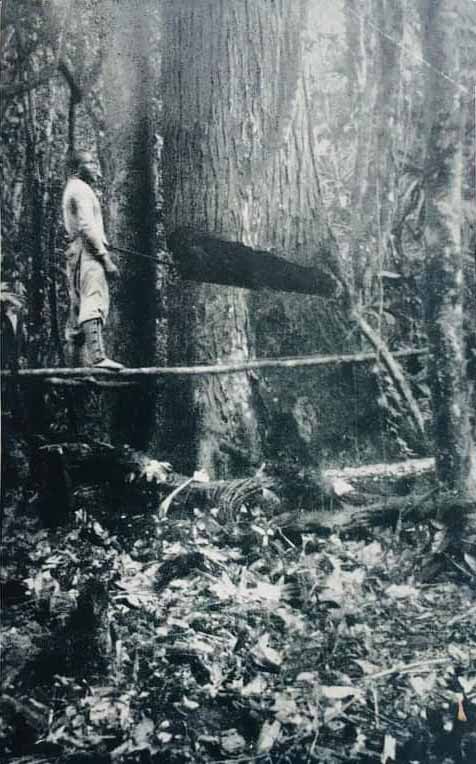
Mahogany tree- Felling operation nearly complete. Source: Handbook of British Honduras by Monrad Metzgen and Henry Cain.
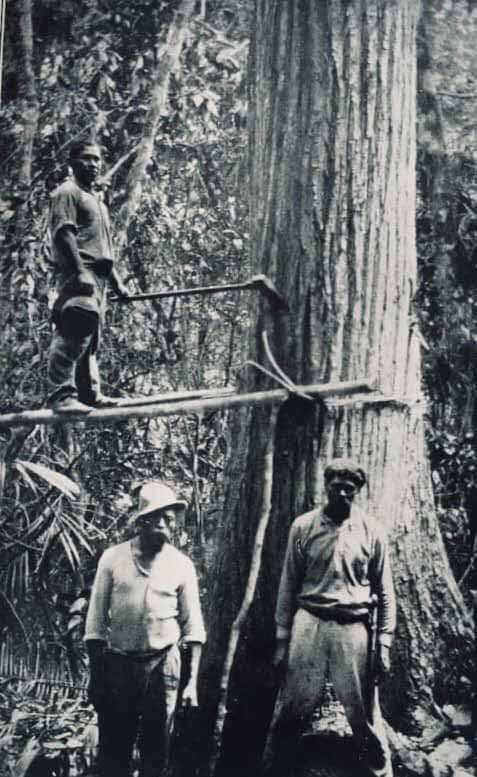

This tree was about 150 feet tall before it was cut, and over 100 years old. Source: Handbook of British Honduras by Monrad Metzgen and Henry Cain.
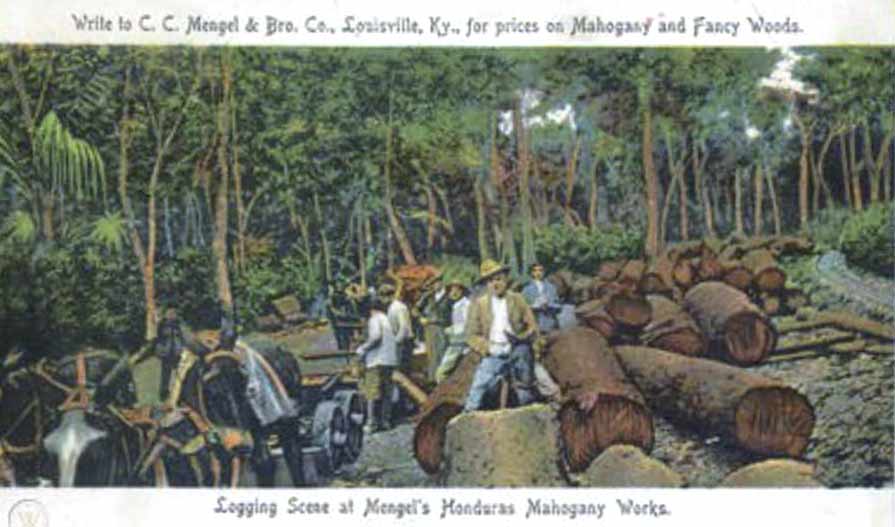
Mengel's Logging Mahogany Works, 1907. Mengel was a huge supplier of Mahogany n Chicle. Robert Turton purchased most of his production and also provided Mengel with the large iron wagons with iron wheels from I.T. Williams. They provided for severe haulage conditons.
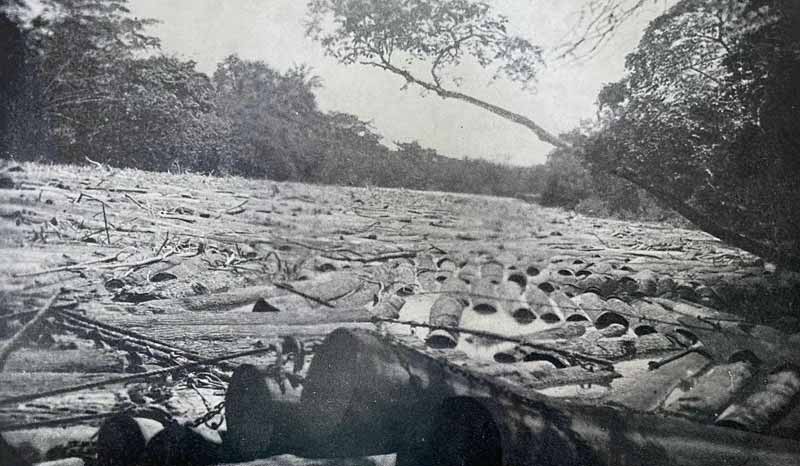
Mahogany logs brought to lower reach of Belize River by flood. Source: Handbook of British Honduras by Monrad Metzgen and Henry Cain.
LET US LEARN ABOUT OUR ORIGINAL AND MAJOR INDUSTRY, "MAHOGANY"
by Hector Silva
This is the industry which gave the Settlement of Belize in the Bay of Honduras, " ITS JUMP START. "
(Hence the Mahogany Tree, which now adorns the Belizean Flag. )
LET US START FROM THE BEGNING.
In the beginning, our exports were mainly, Log Wood, Sponges and perhaps some sea food. Then came the exportation of Coconuts and Copra. - Later came the refugees from the Caste War in Yucatan and they introduced Sugar and Rum from Northern Belize.
There after, Citrus was introduced along with Banana, and down south the Confederates from Southern United States established many small Sugar Factories. - Cattle and other grazing animals followed, such as Mules for the Chicle Industry. - COHUNE Industry came, in the 1940's which created intermediate employment, especially in the Villages.
BUT THE KING INDUSTRY BECAME The extraction and exportation of the Mahogany Logs and to a lesser degree, Pine, Ceder, and other hardwoods for Train Tracks.
MAHOGANY WOOD had a great appeal in the deluxe Furniture Making. - Many special places in England, included the Royalty still has Furniture made from mahogany from Belize.
NOW LET'S GIVE THOSE PERSON THAT HAVE NEVER BEEN IN A DEEP JUNGLE.
A jungle is where the mahogany trees are mostly found. The Jungle is a living organism which breathes and exhales. When you are inside a jungle, you haave to breathe like the Jungle. The air inside is DENSE.
So it began when the Contractors would send the Mahogany hunters in search of the logs, These logs would be marked and trails opened for when the Dry Season began, the STEERS ( castrated Bulls) would be brought to take the logs out to what was called a ( TRUCK PASS or in spanish TROCOPAS, ) not really a truck pass, but an iron wheel trailer, which the same steers would pull loaded with logs to near a River to be floated down when the floods came to LOG BOOM, at todays Burrel Boom.
The place near a river where logs were deposited was called a Baccadier. At the Baccadier, each Contractor would place their designated mark, so that at the Boom it was easier for a contractor to take out his logs.
EXAMPLE. Letter A was contractor Emilio Awe. - - Letter B Contractor Ben Stuart. - - Letter N Contractor Guy Nord. - Letter S Contractor Louis Sylvester Sr. - Letter H Contractor Mervyn Hulse and down the line.
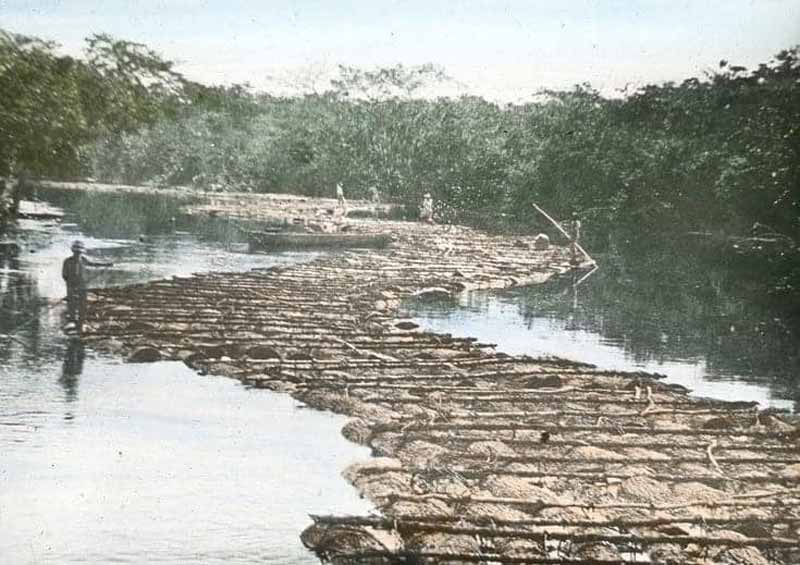
Amazing the number of mahogany logs and the skill it takes to float it down a meandering Belize River for loading onto steamboats for export to Europe. Hard labor goes into finding and cutting each tree, transporting these to the river, and maneuvering the logs down the river. Early sources of labor were enslaved Africans in the late 1700s and then later starting in 1802, Garifuna men imported from Roatan.
Photo credit just above and below: Jesuit Archives
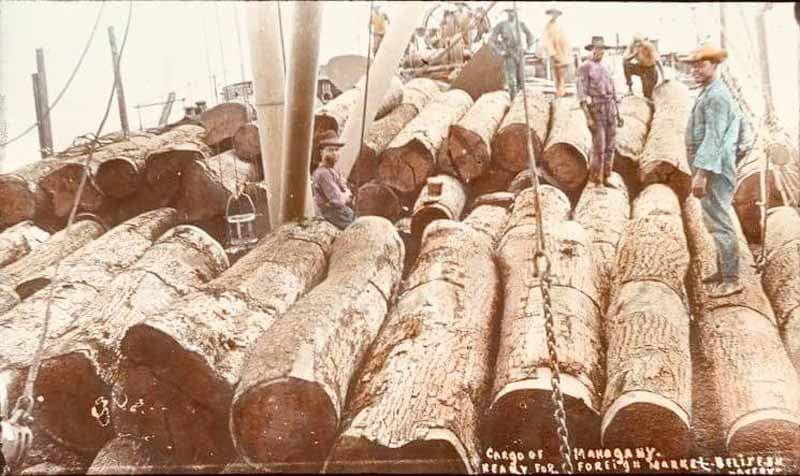

Transport by cattle teams. Source: Handbook of British Honduras by Monrad Metzgen and Henry Cain.
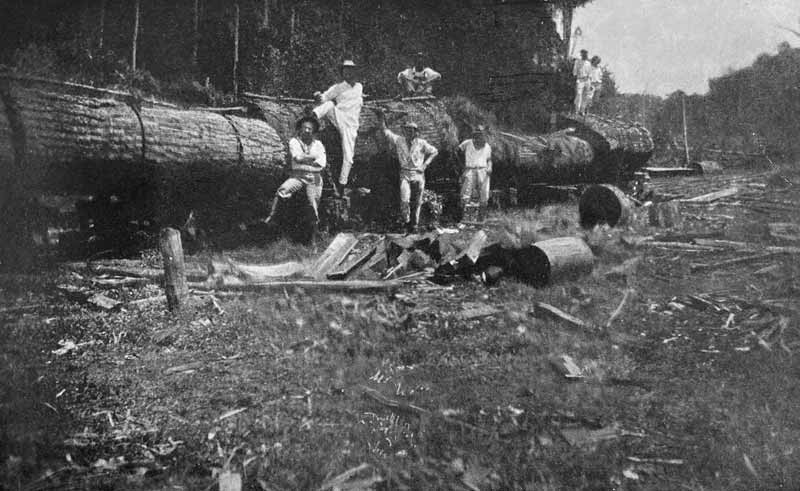
Mahogany tree cut in lengths for transport to river bank. Source: Handbook of British Honduras by Monrad Metzgen and Henry Cain.

Click here for a large selection of photographs and videos of Belize
 Email us - We Email us - We your photographs. Send us yours with a description! your photographs. Send us yours with a description!
 Belize Search.com
Belize Search.com  Belize News.com
Belize News.com  Belize Cards.com
Belize Cards.com  Belize History
Belize History  IslandBazaar.net
IslandBazaar.net  Belize Weather
Belize Weather 
 Belize Lodging
Belize Lodging  Tours & Recreation
Tours & Recreation  Diving & Snorkeling
Diving & Snorkeling  Fishing
Fishing  Travel Tips
Travel Tips  Real Estate
Real Estate 
 AmbergrisCaye.com
AmbergrisCaye.com  Island Information
Island Information  Visitor Center
Visitor Center  Belize Business
Belize Business  San Pedro Sun
San Pedro Sun 
 SanPedroDaily.com
SanPedroDaily.com  Belize Message Board
Belize Message Board  Restaurants
Restaurants  Things to do
Things to do 
|